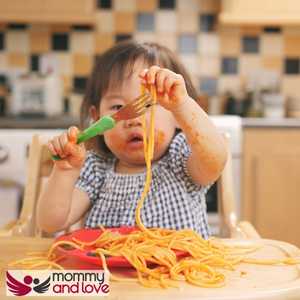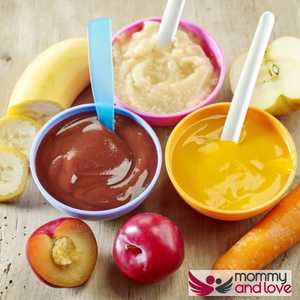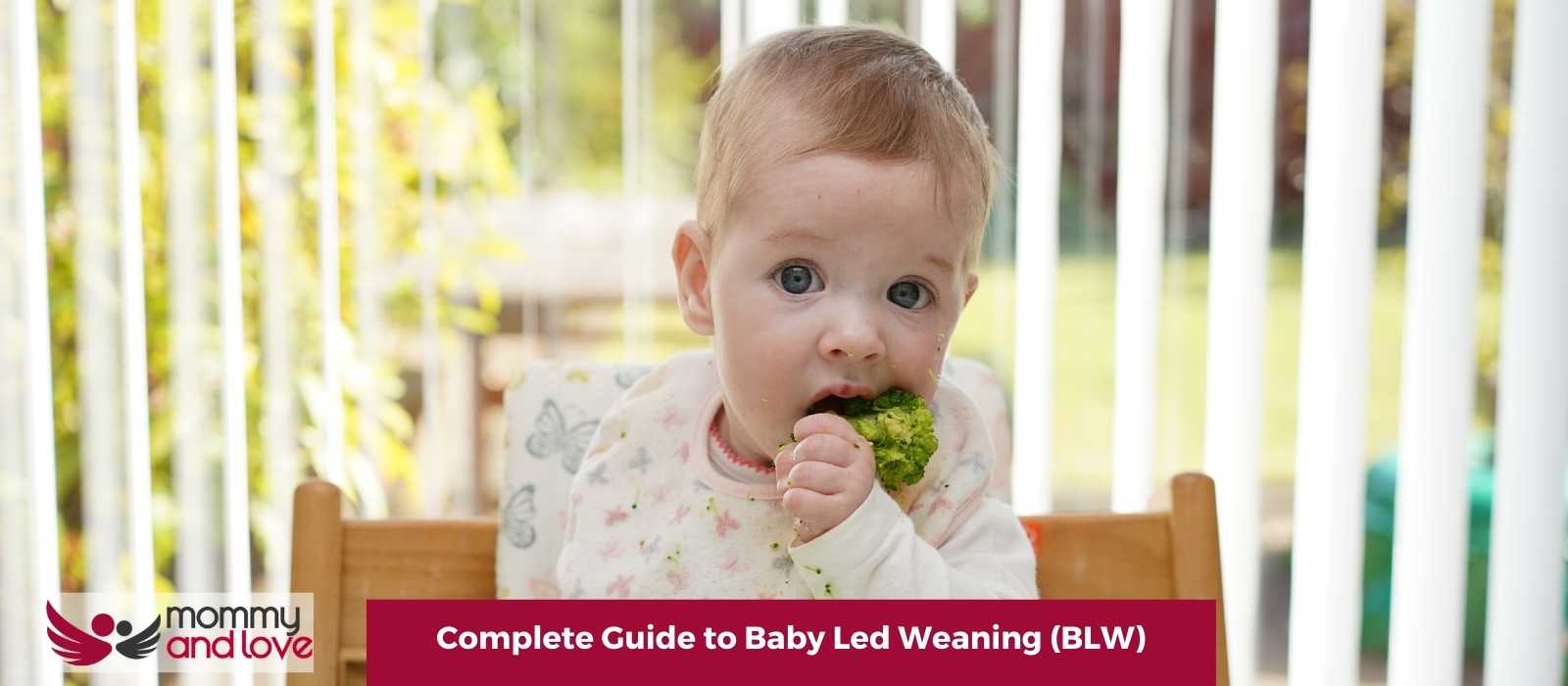BLW is a great way to introduce your baby to solid foods. It allows them to explore new tastes and textures at their own pace, and can help them develop their fine motor skills.
If you’re thinking of trying BLW, here’s everything you need to know about how to get started.
What is Baby Led Weaning?

Baby Led Weaning (BLW) is a method of feeding your baby solid foods, where they feed themselves instead of being fed by you. It is an alternative method to the traditional spoon feeding approach.
It’s a natural way to introduce your baby to solids, and can be a great way to help them develop their motor skills and explore new tastes and textures.
Whilst its called baby led weaning, you are just introducing solid food and letting them put the food into baby’s mouth instead of being spood fed children.
A baby led weaning style allows babies to self feed when starting solid foods. Usually its complementary feeding to what the family are eating, this works best as long as its a healthy diet. The practice of picking up food and the self feed is great for both their gross motor skills and their oral motor skills.
How do I get started with BLW?
There’s no right or wrong way to start BLW, but there are a few things you can do to make it easier for both you and your baby.
Firstly, try to choose soft, easy-to-eat foods that your baby can pick up and chew on their own. You can find a list of recommended foods below. But generally, baby eats what the family eats rather than any specific baby food which has been mushed and puree’d. They learn the art of self feeding and the studies suggest become healthier children.
Secondly, make sure you’re always nearby when your baby is eating to ensure they’re safe and that they’re not eating too much or too little. There is a slightly increased risk of choking and baby gagging when starting solids, but there is also a much healthier weight gain than spoon fed children. Do start with soft food especially if they have few teeth.
Finally, be prepared for mess! BLW can be a messy process, but it’s all part of the fun for both you and your baby.
What are some recommended foods for BLW?
Some great starter foods for BLW include:
-soft fruits like bananas, mangoes, and avocados
-vegetables like cooked sweet potato, pumpkin, and carrots
-cooked meats like chicken or fish
-tofu or other iron rich foods
-yogurt-rice
-pancakes
When they get better skills you can move onto raw apple and other firmer foods.
Can I still use bottles or formula if my baby is on BLW?
There’s no need to stop using bottles or formula if your baby is on BLW. In fact, some parents find that it’s easier to continue using bottles while their baby is starting to eat solid foods.
If you’re using formula, you can simply add it to your baby’s food to make it softer and easier to eat. If you’re using bottles, you can give them to your baby before or after a meal.
What age do you start baby-led weaning?
There is no definitive answer to this question as it depends on the individual child and their abilities. However, many parents start baby-led weaning when their child is around 6 months old. This gives them enough time to develop the skills needed to participate in this type of feeding. Some babies may be ready for BLW at a younger orolder age, so it is important to watch them and see how they are doing. If you have any questions or concerns, consult with your pediatrician.
Do doctors recommend baby-led weaning?
There is no one-size-fits-all answer to this question, as each family and each child is unique and what works for one may not work for another. However, many doctors do recommend baby-led weaning as a healthy and safe way to start solid foods. Baby-led weaning can help your child develop healthy eating habits and learn to listen to their own hunger cues. Additionally, baby-led weaning can be a more relaxed and enjoyable experience for both you and your child.
What does BLW mean when feeding a baby?
BLW stands for Baby Led Weaning. It is a term used to describe a feeding method where babies feed themselves solid foods, rather than being spoon-fed by someone else. This approach allows babies to develop their own eating habits and learn how to chew and swallow food. It can also help them to learn about different flavors and textures.
There are a few things to keep in mind when practising BLW. First, you will need to provide your baby with foods that are soft and easy to chew. You can start with things like cooked vegetables, fruits, and pasta. Second, make sure to keep an eye on your baby while they are eating. They may not be able to chew food properly and could choke on it. Finally, be patient! It may take a little while for your baby to get the hang of eating solid foods. But with time and practice, they will get there!
What is the point of baby-led weaning?
Some parents choose baby-led weaning (BLW) for their children because they feel that it is a more natural way to introduce food. With BLW, the child feeds themselves from the time they are introduced to solid foods instead of being spoon-fed by an adult. Proponents of BLW believe that this method allows the child to develop a better relationship with food and their own hunger cues.
There are also some parents who choose BLW because they feel that it is less work for them. With traditional spoon-feeding, parents have to puree foods and then feed their child one bite at a time. This can be time-consuming and messy. With BLW, the child can feed themselves, which means that parents don’t have to do as much work.
Is baby-led weaning really better?
There are a lot of different opinions out there about baby-led weaning. Some parents swear by it, while others find it to be more trouble than it’s worth. So, what’s the verdict? Is baby-led weaning really better?
The jury is still out on this one. Some studies suggest that baby-led weaning may help babies to eat more slowly and mindfully, which can lead to better self-regulation of food intake later on in life. Other studies have found that baby-led weaning may not make a difference in terms of weight or eating habits.
So, what does this all mean? The truth is, there is no definitive answer. Baby-led weaning may be a great option for some families, while others may find it to be more trouble than it’s worth. Ultimately, the decision of whether or not to try baby-led weaning is up to you and your family.
What is the difference between traditional and baby-led weaning?
There are two different approaches to weaning – traditional weaning and baby-led weaning. With traditional weaning, parents introduce solid foods to their child at around 6 months old, using a spoon to feed them puréed or mashed food. Baby-led weaning involves letting the child feed themselves from the very beginning, starting with finger foods.
There are pros and cons to both methods. With traditional weaning, parents have more control over what their child is eating, as they can ensure that all the food is puréed or mashed. However, this can also be quite time-consuming and some babies may not enjoy eating pureed food. Baby-led weaning can be messier, as babies are likely to make quite a lot of mess when they are feeding themselves. However, some parents feel that this is a more natural way for babies to eat and it can also help them to develop their fine motor skills. There is no right or wrong way to wean your child – ultimately it is up toyou and your baby to decide what works best for them.
What does LED mean in baby-led weaning?
The led means that you allow your baby to choose what to eat. They lead the way. You provide them with a variety of healthy foods, and they decide what, when and how much to eat
This can be a bit messy at first, but it’s a great way to let your baby explore new tastes and textures. And it can save you from hours of pureeing and spoon-feeding!
What are BLW foods?

There is no definitive answer to this question as different babies will have different preferences and tolerances, but some common BLW foods include boiled or mashed vegetables, soft fruits like bananas or avocados, pasta with tomato sauce, and grilled chicken.
It’s important to introduce new foods one at a time and wait a few days before introducing a new food to make sure your baby doesn’t have an adverse reaction.
When it comes to BLW, the sky is the limit! Babies can eat whatever their parents are eating, so long as it’s cut into small pieces and is soft enough to gum. Just start with a small amount and let your baby decide how much they want to eat.
Does baby-led weaning really work?
Some parents swear by baby-led weaning, or letting their babies feed themselves as soon as they are able. Proponents say that it helps babies learn to eat solid foods sooner and develop a healthy relationship with food. Critics argue that baby-led weaning can lead to feeding problems and obesity. So, does it work?
There is no one answer to this question. Some babies take to baby-led weaning like a duck to water, while others may struggle with it. There is no right or wrong way to do it, so ultimately it is up to the parents to decide what works best for their child.
Some babies take naturally to baby-led weaning and eat their first solid foods with ease. Others, however, may have difficulty transitioning from breast milk or formula to solid foods. If your baby is struggling with baby-led weaning, don’t worry – you can always switch to spoon-feeding.
Which is the best food to start weaning a baby?
There is no one-size-fits-all answer to this question, as every baby is different and will have their own preferences. However, some good options to start with include mashed or pureed fruits and vegetables, oatmeal or rice cereal, and yogurt. It’s important to start slowly and introduce new foods one at a time, so you can easily determine if your baby has any allergies or sensitivities.
Is BLW really safe?
There is a lot of debate surrounding the topic of baby-led weaning (BLW). Some people swear by it, while others think that it’s too dangerous. So, is BLW really safe?
There is no easy answer to this question. On the one hand, BLW can be a great way for babies to learn how to eat on their own, and it can help them develop a healthy relationship with food. On the other hand, there is a risk of choking if babies aren’t given the appropriate foods to eat.
What are the Best Finger Foods for Baby?

Parents of newborns often ask about the best finger foods for baby. The answer to this question depends on the age of your child, and of course the family foods that you are eating the house.
Baby generally can have the same foods as the rest of the family when they start to eat solid food.
When I was beginning to let my youngest start self feeding, I ensured that all the family meals were cooked with no salt, so they just had the same food as us, just chopped up small and placed within reach. The baby led weaning approach works best when you combine it with the family meal. Babies will eat food if they see you eating the same food.
This will make family mealtimes much easier and makes baby led weaning feasible. We might have swapped in a few easier meals like swapped out normal potatoes for roasted sweet potato wedges and avoided any potentially allergenic foods for when they start to eat solids. Sweet potatoes were my youngest favourite along with raw vegetables as first foods.
Below are some general guidelines.
For babies under six months old, breast milk or formula is the best source of nutrition. DO NOT give your child any food besides breast milk or formula until they are at least six months old.
Once your child is six months old, you can start to give them solid foods. There are many different types of finger foods that are appropriate for this age group. Some good choices include:
– soft fruits like bananas or avocados
– cooked vegetables like carrots or green beans
– small pieces of cooked meat or fish
– soft, cooked pasta or rice
– unsalted nuts or seeds
It is important to remember that not all of these foods are appropriate for every child. Always be sure to watch your child while they are eating, to make sure they are not choking on any of the food. Some foods can be very difficult for smaller childer so when choosing your baby led weaning foods, make sure you choose age appropriate foods for the baby led feeding. Most babies will be able to eat most of the foods on this list by their first birthday.
When Do I Stop Milk Feeds?
You can stop milk feeds whenever you and your baby are ready. Some mothers continue to breastfeed until their baby is one year old or even older. Others wean their baby before this age. There is no right or wrong answer, it is simply a personal decision.
If you are not sure when the best time to stop milk feeds is, talk to your baby’s healthcare provider. They will be able to help you make the best decision for your child. But you should ensure that the baby food they are eating is fulfilling all their nutritional requirements. When babies first start to eat finger foods, its really just complementary foods to their milk, and not instead of. As your baby starts to eat more finger foods and less milk, you may find that they are not interested in breastfeeding or taking a bottle.
How Do I Know My Baby Is Getting Enough Nutrition?
When you first start giving your baby solid foods, it is important to watch them closely to make sure they are getting enough nutrition. They will be taking in less breast milk but it is vital that healthy children, when eating solids are given a wide range of whole food and nutritious food. Whilst hot dogs might be ok occasionally, they are not the best first foods as they are full of saturated fat! Some signs that your baby is not getting enough nutrition include:
– poor weight gain
– lack of energy
– lack of interest in food
– vomiting or diarrhea
If you notice any of these signs, please consult with your baby healthcare or your public health nurse provider right away.
The Bottom Line on Baby Led Weaning
Baby Led Weaning can be a great way to introduce your child to solid foods, but it is important that you are prepared for the challenges and potential dangers of this approach. Make sure you have knowledgeable pediatrician’s support before starting BLW because there are some things they need to know like if their food allergies or intolerances. It is also crucial that you are aware of the signs of choking, so you can react quickly if necessary.
When done properly, BLW can be a fun and rewarding experience for both you and your child. Just remember to take your time, relax and enjoy the journey!

This article was written by Sandra Baker – full time writer and the mother of four amazing kids (including twins!)
She’s also a breastfeeding counselor and has spent years helping new parents learn how to care for their children. When she’s not writing or caring for her children, Sandra likes to spend time reading and taking walks with her husband.




